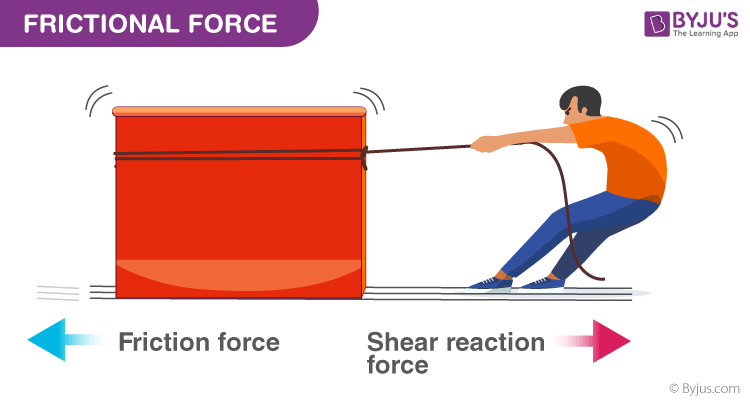Friction is the force that resists motion when the surface of one object comes in contact with the surface of another. The mechanical advantage of a machine is reduced by friction, or in other words, the ratio of output to input is reduced because of friction. An automobile uses one-quarter of its energy on limiting friction. Yet, it is also friction in the tires that allows the car to stay on the road and friction in the clutch that makes it possible to drive. From matches to machines to molecular structures, friction is one of the most significant phenomena in the physical world. In this article, let us discuss frictional force and its different types.
| Table of Contents: |
What Is Frictional Force?
Frictional force is the force generated by two surfaces that contact and slide against each other.
A few factors affecting the frictional force:
- These forces are mainly affected by the surface texture and the amount of force impelling them together.
- The angle and position of the object affect the amount of frictional force.
- If an object is placed flat against an object, then the frictional force will be equal to the object’s weight.
- If an object is pushed against the surface, then the frictional force will be increased and becomes more than the weight of the object.
Here is an engaging video explaining frictional force in detail

Calculating the Force of Friction
The maximum amount of friction force that a surface can apply upon an object can be easily calculated with the use of the given formula:
|
Ffrict = µ • Fnorm |
To help you calculate the frictional force, here we have provided methodical steps to follow while calculating the force of friction.
- Find the Normal Force
The normal force is the support force exerted upon an object that is in contact with another stable object. The normal force can be simply described in most cases by the following formula:
In this formula, m describes the object’s mass, and g stands for the acceleration due to gravity. In the case of an inclined surface, the strength of the normal surface is reduced the more the surface is inclined, hence the formula becomes:
θ represents the angle to the surface is inclined to. In a simple calculation, you would calculate the normal force of a 2-kg block of wood sitting on a surface as N = 2 kg × 9.8 N/kg = 19.6 N
- Finding the Right Co-efficient
The co-efficient you choose depends on the object and the specific situation. If the object isn’t moving across the surface, you use the coefficient of static friction
- Calculating Frictional Force
As discussed, the formula for frictional force is given by F = μN.
As an example, let us consider the block of wood that weighs 2-kg resting on a table to be pushed from rest. In this case, we consider the static friction coefficient. 0.5 is the static coefficient of wood.
With the given details, we can calculate the normal force as N = 2 kg × 9.8 N/kg = 19.6 N Now that we have the values of normal force and static friction co-efficient, we can calculate the frictional force as follows:
F = 0.5 × 19.6 N = 9.8 N

Are there Different Types of Frictional Force?
Yes, there are different types of frictional forces. The friction that takes place between solid surfaces is classified as Static, Kinetic, Rolling, and Sliding Friction. The friction that takes place between fluids and gases is termed as fluid Friction. Hence, friction is broadly classified as:
- Dry Friction
- Static Friction
- Kinetic Friction
- Rolling Friction
- Sliding Friction
- Fluid Friction
Dry Friction
Dry friction describes the reaction between two solid bodies in contact when they are in motion (kinetic friction) and when they are not (static friction). Both static and kinetic friction is proportional to the normal force exerted between the solid bodies. The interaction of different substances is modelled with different coefficients of friction. By this, we mean that certain substances have a higher resistance to movement than others for the same normal force between them. Each of these values are experimentally determined.
Read about the different types of dry friction from the links given below:
| Static Friction | Kinetic Friction |
| Rolling Friction | Sliding Friction |
Watch the video and learn about friction, coefficient of friction and properties of friction

Fluid Friction
Fluid Friction is the force that obstructs the flow of fluid. It is a situation where the fluid provides resistance between the two surfaces. If both surfaces offer high resistance, then it is known as high viscous and, generally, we call them greasy.
Examples of Fluid Friction
- To avoid creaking sounds from doors, we lubricate the door hinges, which leads to the smooth functioning of door hinges.
- When you drop the ball in a full bucket of water, water splashes out of the bucket, and this is all because of the buoyancy of fluid.
Problems on Frictional Force
1. A large block of ice is being pulled across a frozen lake. The block of ice has a mass of 300 kg. The coefficient of friction between two ice surfaces is small: μk = 0.05. What is the force of friction that is acting on the block of ice?
Solution: On a flat surface, the normal force on an object is given by N = mg.
With this, we can find the force of friction as follows:
Ff =μN
Ff =μmg
Substituting the values in the above equation we get,
Ff =0.05 × 300 kg × 9.8 m/s2
= 147 kg-m/s2 or 147 N.
The friction force acting in the opposite direction as the block of ice is pulled across the lake is 147 N.
2. A man has to push his boat on the shore across the mud to get to the water. The coefficient of friction between the boat and the mud is given by μ = 0.400. If the boat has a mass of 40 kg, calculate the magnitude of the force of friction acting on the boat.
Solution: On a flat surface, the normal force on an object is N = mg.
Using this, we can calculate the force of friction as follows:
F = μN F = μ mg Substituting the values in the equation, we get F = (0.400)(40.0 kg)(9.80 m/s2)
F = 156.8 N
The frictional force acting on the boat is 156.8 N.
Basics of friction explained with examples

Frequently Asked Questions – FAQs
State true or false: Surface texture affects the friction force.
What is the formula to calculate the frictional force?
The frictional force is given by the formula: F = μN
What is fluid friction?
What is static friction?
Is frictional force a scalar or a vector?
Stay tuned with BYJU’S to learn more interesting science topics with engaging videos!

1. A force of 5000N pulls an object of mass 150kg and overcomes a frictional force of 270N.
find the acceleration of the object?
2. A crate of mass 7kg is placed on a log wood lying on the ground. If the weight of the log is 30N. Find the reaction of the ground on the log and the crate?
Force of friction is an example of
Force of friction is an example of a contact force. Contact forces are forces that result when the two interacting objects are perceived to be physically contacting each other.